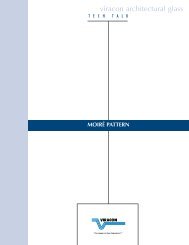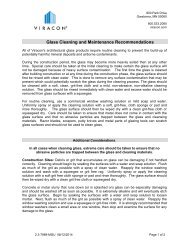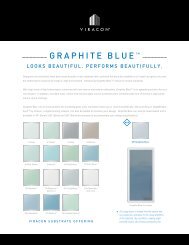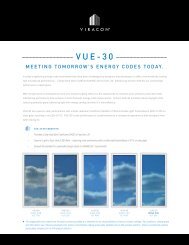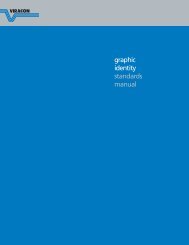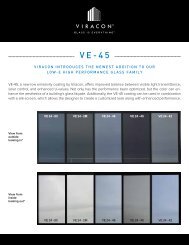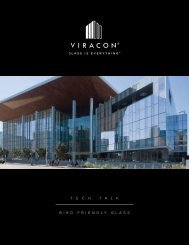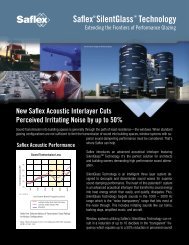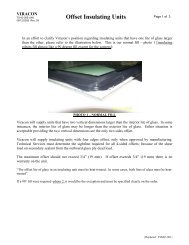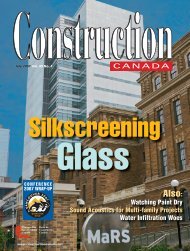2 0 1 3 P R O D U C T G U I D E VIRACON PRODUCT GUIDE 2013 ...
2 0 1 3 P R O D U C T G U I D E VIRACON PRODUCT GUIDE 2013 ...
2 0 1 3 P R O D U C T G U I D E VIRACON PRODUCT GUIDE 2013 ...
Create successful ePaper yourself
Turn your PDF publications into a flip-book with our unique Google optimized e-Paper software.
GLOSSARY<br />
Etch: To alter the surface of glass with hydrofluoric acid or other caustic agents. Permanent etching of glass may occur from<br />
alkali and other runoff from surrounding building materials.<br />
Float Glass: Glass formed on a bath of molten tin. The surface in contact with the tin is known as the tin surface or tin side.<br />
The top surface is known as the atmosphere surface or air side.<br />
Fully Tempered Glass (FT): Glass that has been heat-treated to have either a minimum surface compression of 10000 psi<br />
or an edge compression not less than 9700 psi in accordance with the requirements of ASTM C 1048 kind FT or meet the<br />
requirements of ANSI Z97.1 or CPSC 16 CFR 1201 safety glazing standards. Tempered glass is 4-5 times stronger than annealed<br />
glass and when broken breaks into small relatively harmless pieces.<br />
Glazing: (n) A generic term used to describe an infill material such as glass. (v) The process of installing an infill material into a<br />
prepared opening in windows, door panels, partitions, etc.<br />
Ground Edge: A special fabrication done to the edge of a piece of glass. Makes the edge smooth and gives it a whitish/gray<br />
appearance.<br />
Heat Soak: A process of heating glass to a specific temperature for a specified time in a special oven in an attempt to find any<br />
impurities in the glass known as “nickel sulfide inclusions”.<br />
Heat Strengthened (HS): Glass that has been heat-treated to have a surface compression between 3500 and 7500 psi and<br />
meet the requirements for ASTM C 1048 kind HS. It is ~2-3 times the strength of annealed glass. Heat-strengthened glass is<br />
not a safety glazing material and will not meet the requirements of ANSI Z97.1 or CPSC 16 CFR 1201.<br />
Heat Transfer Methods: Heat transfers from one place to another via convection conduction or radiation. Convection occurs<br />
from the upward movement of warm light air currents. Conduction occurs when energy passes from one object to another.<br />
Radiation occurs when heat is sent through space and is capable of traveling to a distant object where it can be reflected<br />
absorbed or transmitted.<br />
Heat Treated: Term used for both fully tempered glass and heat-strengthened glass.<br />
Hurricane / cyclic wind-resistant glass: Laminated glazing tested to one or more test protocols for high velocity hurricane<br />
winds and windborne debris.<br />
Infrared (IR): IR is part of the solar spectrum or sunlight that is invisible to the human eye. It has a wavelength range of ~790-<br />
3000 nanometers and has a penetrating heat effect. Short-wave IR converts to heat when it is absorbed by an object.<br />
Insulating Glass (IG): Two glass components separated by an air spacer and hermetically sealed. Inherently insulating glass<br />
increases a window’s thermal performance.<br />
Insulating Laminated Glass: An insulating glass unit in which the exterior component is a monolithic glass ply and the interior<br />
component is laminated glass.<br />
Interlayer: Refers to the plastic or vinyl in a laminated unit.<br />
Iridescence: Also called strain pattern or Q-lines. It is a pattern in heat treated glass not normally visible except under certain<br />
lighting conditions. It is especially visible with the use of a polarized lens. Iridescence is an inherent characteristic of heat<br />
treated glass.<br />
Laminated Glass: Two or more pieces of glass bonded together by a piece of plastic/vinyl called polyvinyl butyral (PVB.) A<br />
minimum interlayer thickness of .030 (.76mm) meets the requirements of ANSI Z97.1 or CPSC 16 CFR 1201 safety glazing standards.<br />
Laminated Insulating Glass: An insulating glass unit in which the exterior component is a laminated glass and the interior<br />
component is a monolithic glass ply.<br />
Light to Solar Gain Ratio (LSG): The ratio is equal to the Visible Light Transmittance divided by the Solar Heat Gain Coefficient.<br />
The Department of Energy's Federal Technology Alert publication of the Federal Energy Management Program (FEMP) views<br />
an LSG of 1.25 or greater to be Green Glazing/Spectrally Selective Glazing.<br />
130<br />
<strong>VIRACON</strong> // RESOURCES



